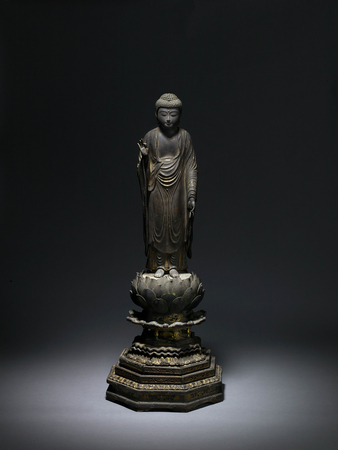Product Description
7357 A gilt-wood figure of Amida Buddha standing on an elaborately decorated lotus pedestal base with the hands in the an-i-in mudra. The head has gyokugan (inlaid crystal eyes) and is also adorned with crystals representing the byakugō (white spiralling hair) on the forehead and the nikkei-shu (red jewel on the protrusion on top of the Buddha’s head). The robe is delicately decorated in gold and black lacquer with key-fret patterns, floral designs and a stylised lotus flower enclosed in a circle on the back of the figure. The petals of the lotus base are accentuated in kirikane (thin cut strips of gold leaf).
Japan 12th/13th century Kamakura period
Dimensions:
Figure and stand: H. 33¼” (84cm)
Figure: H. 19¾” (50cm)
There are six forms of the an-i-in mudra each representing one of the nine Esoteric Amidas, the so called Middle and Lower classes. Lower class mudras are represented by the right hand raised to shoulder level and the left hand pointing down with palm upward. The circle formed by the fingers, a complete form, having neither beginning nor end, is that of perfection and resembles the Law of Buddha, which is perfect and eternal.
Belief in Amida as Lord of the Western Paradise rose in popularity during the late 10th century. Based primarily on the concept of salvation through faith, it was not only a religion which appealed to a broad range of people, but also a direct assertion of piety against the dogmatic and esoteric ritual of the more traditional Tendai and Shingon sects. In Amida’s Western Paradise the faithful are reborn, to progress through various stages of increasing awareness until finally achieving complete enlightenment.
Images of Amida, Lord of the Western Paradise, are known in Japan from as early as the 7th century. Until the 11th century the deity was most frequently portrayed in a gesture of teaching and was worshiped primarily in memorial rituals for the deceased. However in the last two centuries of the Heian period worshippers started to concentrate more on the ‘Teachings Essential for Rebirth’ written by the Tendai monk Genshin (942-1017). The teachings describe the horrors of Buddhist hell and the glories of the Western Paradise that can be attained through nembutsu, meditation on Amida or the recitation of the deity’s name.
Despite the apparent absence of formal variations in the images themselves, during the latter part of the Heian period important changes did occur in the nature of the rituals held in front of the Lord of the Western Paradise. By the twelfth century Image Halls dedicated to Amida were the ritual centres of most complexes. The function of memorial services was expanded so they benefited not only the dead, but the living to. Even rituals with no historical connection to the deity, such as the important services at the start of the New Year, were also held there. Of particular significance were the novel ritual practices that were held to guarantee one’s rebirth in Amida’s Western Paradise. Some, such as the re-enactment of the descent of Amida or the passing of one’s last moments before death clutching a cord attached to the hands of the deity, were entirely new whilst others, which included the use of halls dedicated to Amida as temporary places of interment, reflected the fusion of more ancient practices with doctrines of rebirth.
For a similar mid-late 13th century standing Amida Nyorai in the collection of Mr and Mrs John D. Rockefeller 3rd see: Kamakura, Realism and Spirituality in the Sculpture of Japan, 2016 p.102, pl.25












